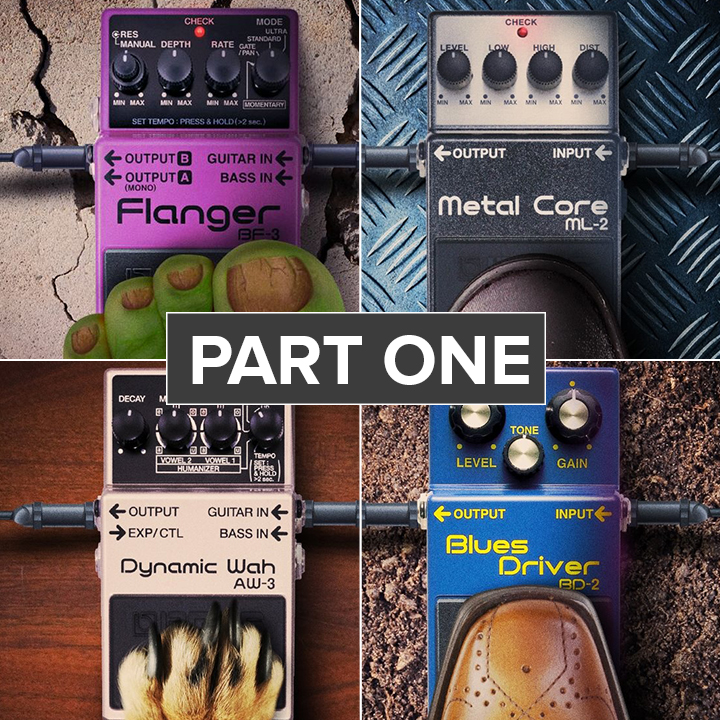There are No Rules!
So you decided to play electric guitar. Once you get a guitar and an amp, the next step is to explore effects. Effects pedals can be separated into groups based on their functions. Understanding the different pedal groups is the key to getting the best sound when chaining them together. The largest pedal group is probably overdrives and distortions, and BOSS currently makes 16 different pedals in this category. For our example pedal board, we’ll pick the ST-2 Power Stack. Another category with many choices is modulation.These are effects like flanger, phaser, chorus, tremolo, and others. Let’s use the most versatile of these—the BF-3 Flanger. Another group is ambience effects, such as delays and reverbs. We’ll use one of each: a DD-7 Digital Delay and the FRV-1 ’63 Fender Reverb. There are some pedal effects that can add notes or alter the pitch of what you’re playing. For want of a more esoteric name, we’ll call these “pitch-altering” pedals. From this category, let’s throw in a BOSS OC-3 Octave.
Contributed by Roland US Team
BOSS also has a few pedals that make your instrument sound like some other instrument. The AC-3 Acoustic Simulator will do the job. Some effects change your sound with filtering. This effect type can be used in different places in the signal path, so we’ll use the GE-7 Graphic EQ. A few BOSS effects defy categorization, but are nevertheless very useful in any signal path. The most common of these is the CS-3 Compression/Sustainer. Loopers fall into this category also, so let’s add an RC-3 Loop Station to the mix. And you might want the NS-2 Noise Suppressor to kill the noise in your rig, so let’s add that in, too. What about a tuner? The TU-3 is the most popular pedal tuner in the world.
So, where does each pedal go in the signal path? Here are some tips to keep in mind before you start plugging pedals together:
Rule 1—There are no rules. The sound you’re after might not be made by what we could call the appropriate or logical signal path, but that’s not always the issue. The issue is this: what does it sound like? If it makes the sound you’re after, then it’s right…although, you may have to do something about the noise. Traditional pedal board arrangements were designed for certain reasons, and keeping the noise down is one biggie. Following the principles of how sound is made in physical space is another (see Rule 4 coming up). But the final choice is yours. As a very wise man said: if it works, don’t fix it.
Rule 2—Some pedal types work better in certain parts of the signal path than in others. Octave pedals or tuners, for example, don’t work as well with a distorted signal as with an undistorted signal, so they should be placed before the distortion.
Rule 3—Noise can be a problem, particularly with high-gain distortion sounds. Pedals that can add volume—such as compressors, wahs, EQs, and overdrive/distortions—will also amplify any noise created by the effects placed before them.
Rule 4—Taking sound-making devices like stompbox pedals out of the equation, there’s an order to the way sounds naturally occur in physical space. For example, guitar amp distortion is made in physical space by turning an amp up enough to cause its circuits to overload, and any echo you might hear happens after the distorted sound hits walls or ceilings and bounces back to your ears. Therefore, logic says that your reverb and/or delay pedals should be last in the signal path, since that is how the sounds they produce actually occur in three-dimensional space.
In keeping with these rules—okay, they aren’t really rules, so let’s compromise and call them “guidelines”—here are some essential concepts for lining your pedals up:
- Pedals that amplify or add noise should go near the beginning of the signal path. This includes overdrive/distortion effects, compressors, and wah pedals. If they’re later in the signal path, they will amplify the noise of everything before them, which can be difficult to control.
- Pedals that produce tone go before things that modify tone. This is logical, because you want to create your basic sound first, then tweak it with some kind of modifying effect. For example, this means that overdrives go before chorus effects.
- Pedals that create ambience go last. This goes back to the “how does sound actually occur in physical space” idea. So, delay and reverb should go after all other effects.
We will continue this conversation soon. In the meantime, click on the image below to experience BOSS effects connected to each other.







